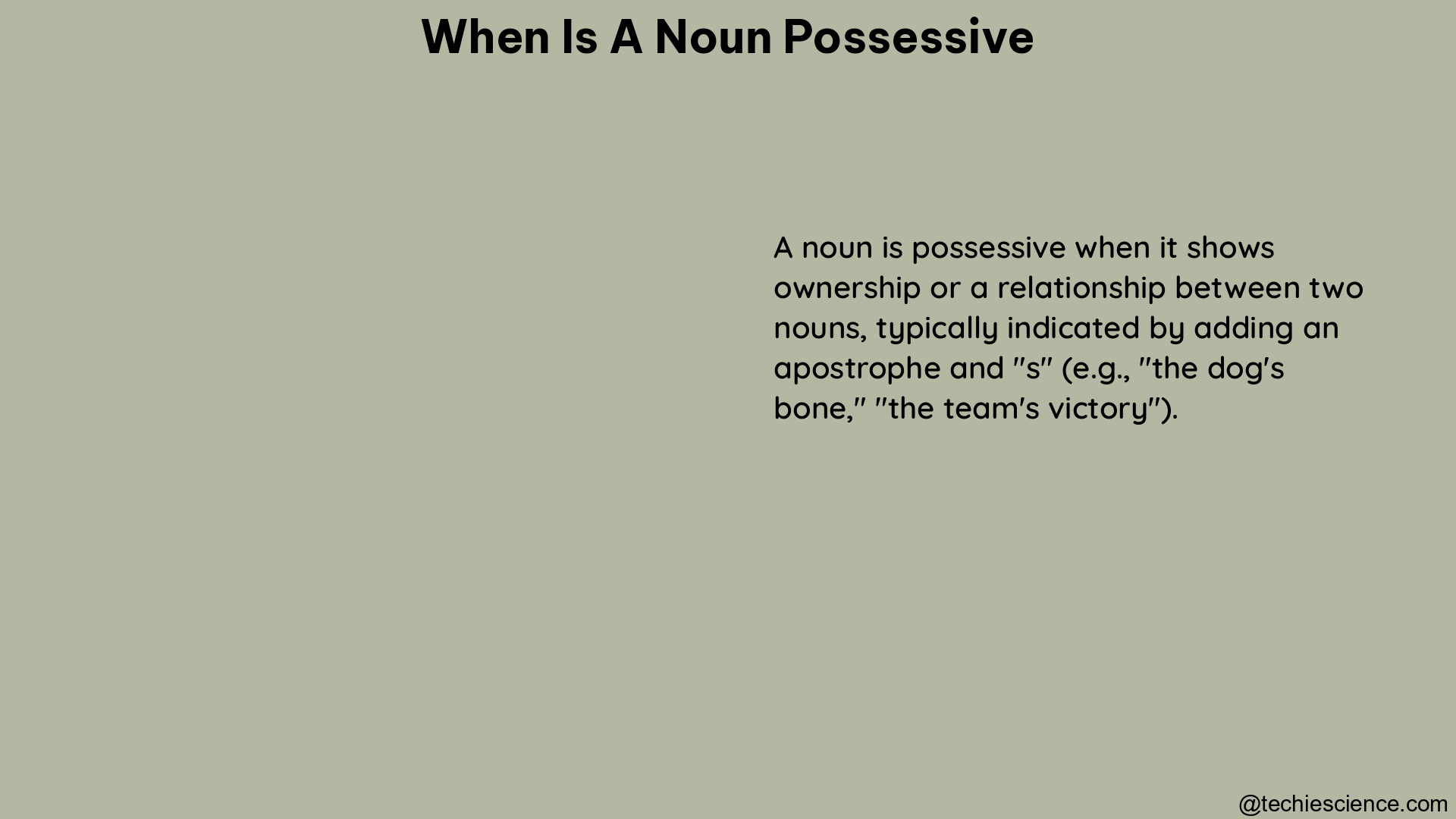Nouns can take on a possessive form to indicate ownership or a direct connection to another noun. Mastering the rules of possessive nouns is crucial for effective written communication. In this comprehensive guide, we will delve into the intricacies of when a noun is considered possessive, exploring the various scenarios and exceptions that can arise.
Singular Possessives
Singular Nouns
When a singular noun is used to indicate possession or a direct relationship, an apostrophe and the letter “s” are added to the end of the noun. This is the most common form of possessive nouns. For example:
- “The dog’s bone” (the bone belongs to the dog)
- “The student’s notebook” (the notebook belongs to the student)
Singular Nouns Ending in “s”
For singular nouns that already end in the letter “s,” there are two acceptable ways to form the possessive:
- Add an apostrophe and “s”:
-
Example: “James’s car” (the car belongs to James)
-
Add only an apostrophe:
- Example: “James’ car” (the car belongs to James)
The choice between these two options often depends on the style guide or personal preference, but both are considered correct.
Plural Possessives

Plural Nouns Ending in “s”
When forming the possessive for plural nouns that already end in the letter “s,” you only need to add an apostrophe. This is the most common form of plural possessives. For example:
- “The boys’ toys” (the toys belong to the boys)
- “The teachers’ lounge” (the lounge belongs to the teachers)
Irregular Plural Nouns
For irregular plural nouns, which do not end in “s,” the possessive form is created by adding an apostrophe and “s” to the end of the noun. Examples include:
- “The children’s playground” (the playground belongs to the children)
- “The women’s rights” (the rights belong to the women)
Multiple Nouns
Joint Possession
When two or more nouns jointly possess something, the possessive form is applied only to the last noun in the group. For example:
- “Mike and Amanda’s new loft apartment” (the apartment belongs to both Mike and Amanda)
Individual Possession
If each noun in a group is possessing something individually, the possessive form is applied to each noun. For example:
- “Mike’s and Amanda’s schedules” (each person has their own schedule)
Possessive vs. Appositive
It’s important to distinguish between possessive nouns and appositives, as they serve different grammatical functions.
Possessive
Possessive nouns indicate ownership or a direct connection between two nouns. For example:
- “The farmer’s pitchfork” (the pitchfork belongs to the farmer)
Appositive
Appositives provide additional information about a noun, but do not indicate ownership or a direct connection. For example:
- “The housekeeper cleaned the hotel room” (the room is part of the hotel, not owned by it)
Compound Nouns
Hyphenated Compound Nouns
When dealing with hyphenated compound nouns, the possessive form is added to the last word in the compound. For example:
- “My mother-in-law’s recipe” (the recipe belongs to the mother-in-law)
Irregular Possessives
Names Ending in “s”
For names that already end in the letter “s,” there are two acceptable ways to form the possessive:
- Add an apostrophe and “s”:
-
Example: “Jesus’s teachings” (the teachings belong to Jesus)
-
Add only an apostrophe:
- Example: “Jesus’ teachings” (the teachings belong to Jesus)
Again, the choice between these two options often depends on the style guide or personal preference.
Key Takeaways
- Possessive nouns are used to show ownership or a direct connection between two nouns.
- Singular nouns typically add an apostrophe and “s” to form the possessive.
- Plural nouns ending in “s” add only an apostrophe, while irregular plural nouns add an apostrophe and “s.”
- Compound possessives can be formed by changing the last noun or each noun individually.
- Possessive nouns are distinct from appositives, which provide additional information about a noun.
- There are some irregular possessive forms, such as for names ending in “s.”
By understanding these comprehensive rules and guidelines, you can confidently navigate the nuances of possessive nouns and enhance your written communication skills.
References:
– https://www-s3-live.kent.edu/s3fs-root/s3fs-public/file/possessive-nouns.pdf?VersionId=uPNfamxuv5ksQyblaln5WVnFACXDU_Zl
– https://www.grammarly.com/blog/possessive-case/
– https://www.scribbr.com/nouns-and-pronouns/possessive-noun/
– https://www.yourdictionary.com/articles/possessive-nouns
– https://www.grammarly.com/blog/possessive-nouns/

Hi, My name is Ammu Shaji. I hail from Kerala. I hold a post-graduate degree in English Language and Literature. I am an Academic writer by passion and profession.